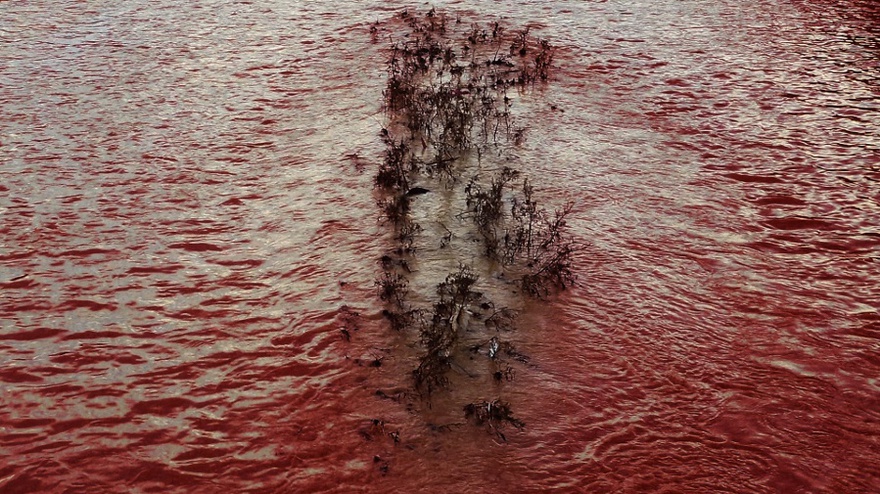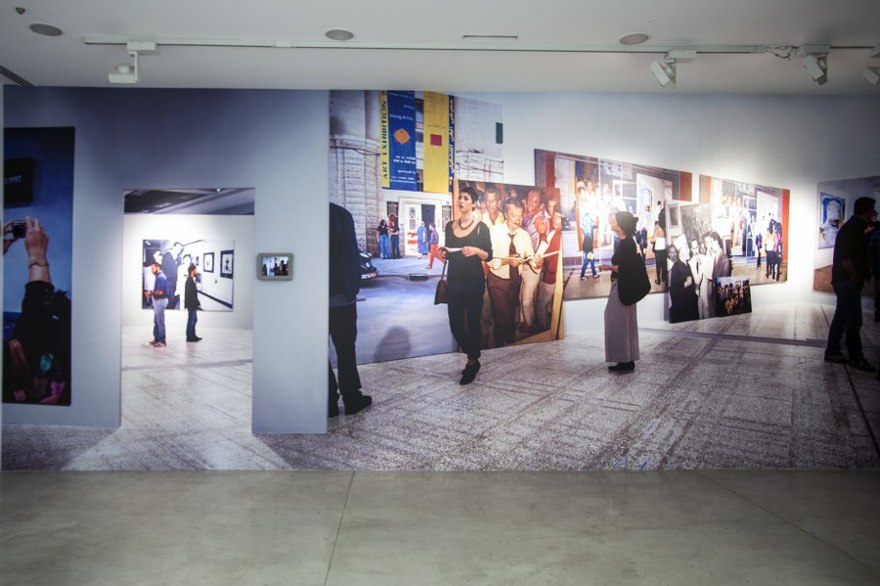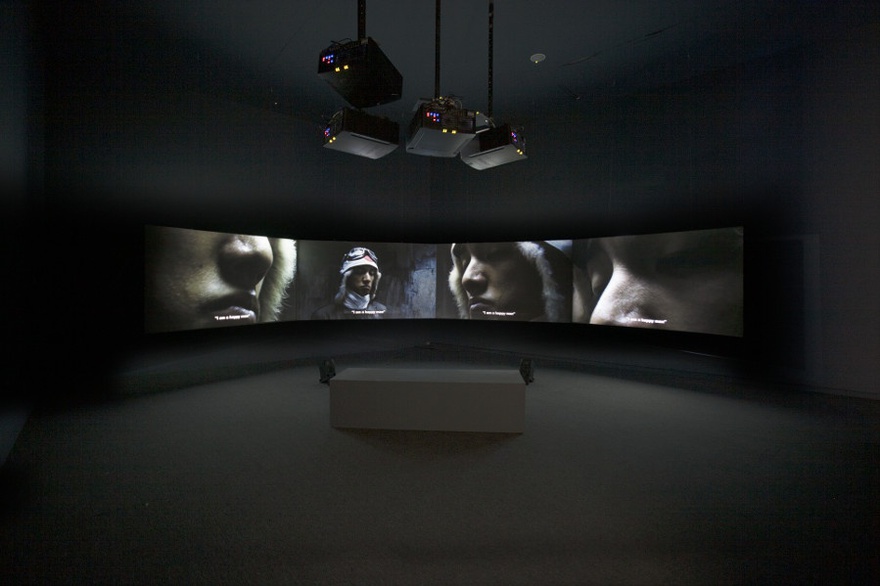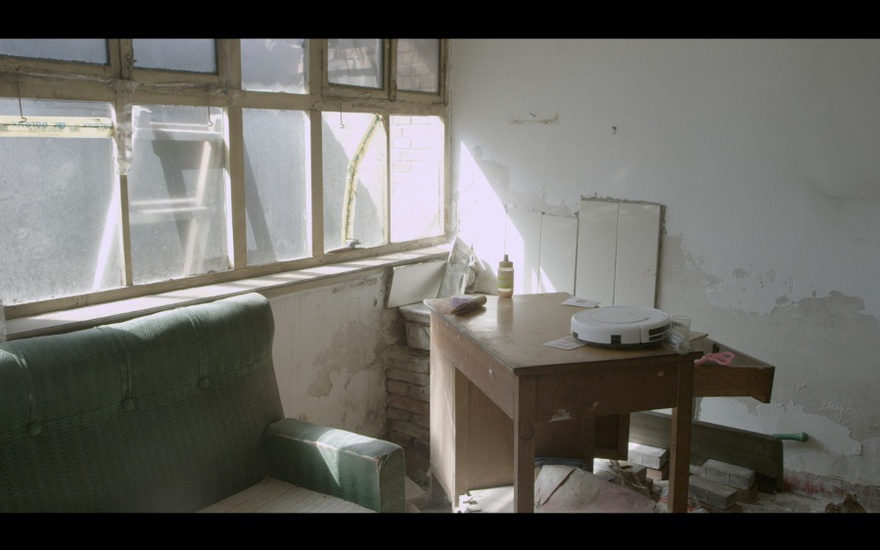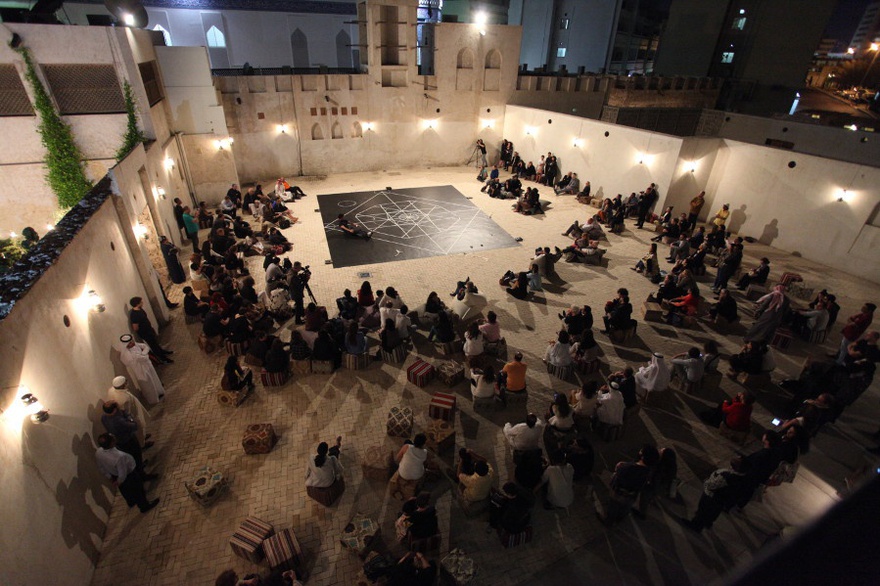Interviews
The Time is Out of Joint
Tarek Abou El Fetouh in conversation with Stephanie Bailey
The Time Is Out Of Joint offers three years and three events as a curatorial frame: the first Biennale of Arab Arts in Baghdad in 1974, the China/Avant-Garde exhibition, held in Beijing in 1989, and the Equator Conference, which will be staged in Yogyakarta in 2022. As the exhibition statement explains, this framework builds on 'Ibn Arabi's concept of time as a fluid place and place as a frozen time, the project examines our current and future locations and conditions. It confuses different times, places, cities and artistic events that took place in the past or will take time in the future.' The project consists of an exhibition staged at the Sharjah Art Foundation, which included a staging of the 2022 Yogyakarta conference in March 2016, a two-volume publication that is divided into the four chapters, and components of the project presented in Gwangju South Korea at the Asia Cultural Center in April 2016. In this remarkable and expansive layering of context, curator Tarek Abou El Fetouh presents a history of corresponding temporalities that recalls both our inability to deal with the complexities of our time, and the necessity to draw connections between us, beyond our defined 'regions'.
Stephanie Bailey: The Time is Out of Joint reflects on history as a string theory of tangled knots, webs, projections and compressions. The intention behind this perspective – and tactic – seems to be a neutralization of the binary divisions between the so-called postcolonial and imperial nations of the world in order to understand who we are without reducing ourselves to fit the normative terms that have historically defined us. This question of how we might find agency in cross-cartographical hybridity has been asked among many within the art world, and The Time Is Out Of Joint is an exhibition that really speaks to this conversation, in terms of trying to find new ways of considering the world and who we are in it, together.
Tarek Abou El Fetouh: In a way, yes, because I am strongly proposing the notion of cosmopolitanism, and posing moments in history between different places that are not necessarily linked with one another. I also avoided the postcolonial in order to go beyond it. If you look at the whole publication that accompanied the exhibition, you will not find the word postcolonial anywhere, because I wanted to look at the context within, and not in relation to the 'other' – that is, I wanted to think about things internally. Right now, the status of the nation, as we know it, is collapsing. With the cases of Syria and Iraq, we are living in a region where the crises are around us. This is, in a way, a development on the first phase of the project, which I staged as an exhibition in Beirut in 2013 as part of Home Works 6. But that was also slightly different; back then, we were thinking about the revolutionary moment but not within the circumstances of the nation state collapsing. Today, Iraq and Syria are both collapsing, and it seems there is no way out of that fate, whatever might happen. It is kind of a disastrous moment that I wanted to explore through this project.
SB: This expression of a cosmopolitanism situated within the current moment, as you say, includes a broader perspective of the world. Your framework replaces 'region' with relation. In many ways, you are activating the art world as a space within which culture and the histories might exist within relational, rather than formative or defined, space.
TAEF: I think the contemporary art world is one of the successful examples of cosmopolitanism, because it operates through a huge network of biennials, residencies, production grants, and so on. Of course, many people are excluded, but still there is a great number of people who move around from one biennial to another, from one city to another, who are making references between the things they see and the places they go, and are working with and from multiple archives. This is why there really can be no such thing as 'Arab art', even if an institution tries to impose an idea of it. It's not true because it doesn't matter anymore where you come from.
SB: How did this inform the framework of The Time is Out of Joint?
TAEF: The title, The Time Is Out of Joint, holds within it the idea that we can move in between different times and different places, but it also has this echo from Hamlet, from which the title is taken, of being in a disastrous moment. Thematically, the disaster is shown in different cases. For example, the current disaster in the Baghdad of 2016 is apparent, I am also proposing a leap to the moment of 1974 when the first Arab Biennial was organized. This remarkable event was organized at a moment, the Arab Nationalism ideology had a short revival, the intellectuals and thinkers who thought about it, including Edward Said, always defined it as a kind of identity that can include different people, such as the Kurds and so on. This, as we have experienced it, was not true. Arab nationalism oppressed a different kind of sub-identity that is now exploding; there is a slave market in Iraq – that's something that we really have to remember: the minorities are taken as slaves. The Yazidi women that are sold in the slave market, for example, have no rights. A few years ago, that was beyond our imagination.
SB: This notion of an internal imperialism, in which minorities are subject to what you might call a colonizing process, connects to the context of China, which you link to in this exhibition by referencing the China Avant/Garde exhibition of 1989, which was held – and shut down – just a few months before the Tiananmen Square crackdown. In China, you also have what some might call the suppression of minorities such as the Uighurs in Xinjiang, or even the Cantonese, who have had to defend the use of their language in schools in recent years from government policymakers who want to make Hanyu – the language of the dominant Han Chinese – the main language of the entire state. At Art Basel Hong Kong in 2016, Oscar Murillo talked about Latin America having the same problems in terms of an internal subjugation of peoples, or of the postcolonial site acting colonially.
This is maybe why the nation state is collapsing – it's collapsing under its own complexity, or rather, its insistence on erasing the complexity within its defined borders in order to somehow reach a pure form: the nation state. What you propose is that this is a global condition.
TAEF: I think there are specific concepts and ideas that we have to unravel, undo, and think about, which are essential at the moment. I think minorities are a big part of this, not only in the Arab world, but everywhere. You can see this with the first Arab Art Biennial of 1974, with its very clear introduction statement in the catalogue that this would only be for Arab artists. This exclusion is something I'm looking at very critically at the moment, which you can see as soon as you walk into the exhibition in Sharjah, when you are confronted with Khalil Rabah's Art Exhibition (2011), a piece about exhibition making Palestine – the continuous problem that the Arab Nationalists promised to solve and couldn't. Then you see Meiro Koizumi's four-channel video installation, Portrait of a Young Samurai (2009), which is a work that is actually tackling the issue of nationalism, too, but from the perspective of Japan. The actor in Koizumi's film is really charged, because he is responding to the artist's instruction, which was to express nationalist feelings and make sacred his emotional link to the concept of the father and the mother. So what you see in the film is this man looking at this letter and getting more and more charged, slowly, to the extent that he explodes emotionally.
SB: This push towards an emotional explosion recalls the way you make an initial reference to the First Arab Art Biennale in Baghdad as a curatorial frame in this particular section of the show in order to completely break it down.
TAEF: Yes, because I am criticising the First Arab Art Biennale. I wanted to have this shock between the reference to the First Arab Art Biennale of 1974 as a thematic frame, and the reality of including different artists from Singapore, China or Japan within it, tackling the same issues critically.
I think audiences were confused by the exhibition proposing critical questions on Arab Nationalism because in Arabic this is a very positive word at least within the intellectual scene. This was not the case with the English speaking audience because nationalism in English can already have a slightly negative connotation. Some of the Arabic-speaking audience were even asking me: 'do you really mean that Arab Nationalism was a mistake?' And I said, at least the way it manifested on the ground in reality can be questioned. There were lots of people who were oppressed and I think this is maybe something we need to discuss or reflect on.
SB: Koizumi's work actually brings to mind Hamlet as a metaphor for the loss of the nation-state-as-patriarch – the kind of lamentation of the lost father that Sulayman Al-Bassam actually appropriated for his theatrical piece, The Al-Hamlet Summit, which Barrak Alzaid writes about for Platform 010. Throughout this part of the exhibition in Sharjah, in fact, there is always this deep sense of loss within the works. As I walked out of Koizumi's installation, for example, I could hear the haunting soundtrack coming from Tzu-Nyen Ho's Pythagoras (2013), which is a dark room behind a red curtain, in which we see, beyond a series of black cubes set up in the centre, a curtain with fans positioned behind it so that it continuously billows, on which projections of curtains are screened upon it. With the Portrait of a Young Samurai still fresh in my mind, I moved through Pythagoras and emerged only to come face to face with Ali Cherri's Pipe Dreams, by which time I felt moved to tears. Of course, Pipe Dreams is an older work, from 2013, and yet it was perfectly positioned here, now, with the optimism of a Syrian flight into space, and the image of astronauts speaking to the nation's father, Hafez Al-Assad. The effect of looking at it today is totally different to when it was made, only three years ago, precisely because of what has happened in Syria since.
TAEF: Actually, when thinking about this part of the exhibition, I was hesitating between Portrait of a Young Samurai and another piece by Koizumi called Where the Silence Fails (2013). In this video, an 80-year-old ex-kamikaze pilot writes a letter to his friend, and then acts out the role of his friend – another pilot who succeeded in the same operation in which the old man failed, which is why he has lived his whole life in shame. Meiro staged this conversation between both characters, asking this old man to re-enact or embody the personality of his dead friend. I started to cry immediately. I thought this is really too emotional – at least in Portrait of a Young Samurai, we see an actor, and not a real personality.
SB: So while inducing a kind of emotional state, you also retained a certain objectivity, which makes sense, given the way we all internalize the failures – and successes – of the nation states to which we belong, or become absorbed by. This kind of distance was also created through bringing together artists from all over the world together, from Singapore to Dubai to China, under the frame of a national – and historical – biennale. The local-global dialectic is constantly at play – that is, it is always moving, and never remains still, solid, or certain.
TAEF: Of course, in a way we go back to the observations you made about the global at the moment at the start of this conversation, and the fact that such issues are being criticised or represented in different ways by different artists from different parts of the world, though these conversations do not always get the platform that they need. I am purposefully criticising the way that the First Arab Art Biennale excluded everyone except Arab artists, although I recognise that these artists wanted to meet and it was at a time in which it was very difficult to meet, in some countries at that time no body can travel without an exit visa. This was the case in Iraq, Syria, and Egypt at the time. So I'm not questioning the motivation behind the biennale, nor the need for it at the time, but I am questioning the idea. This brings me back to the notion of cosmopolitanism.
SB: But when you think about Baghdad in 1974 and Beijing in 1989, this period had everything to do with the burgeoning politics that was developing as a direct result of western hegemony and imperial meddling. It would seem that the criticism you have is not so much about the Arab Biennale of 1974 as an event, but about the way we hold on to that event today.
TAEF: I also really wanted to have the two moments together. I wanted people to think about Baghdad in 2016 and Baghdad in 1974 and to reflect on the idea. The First Arab Art Biennale in Baghdad was about an Arab art that comes from Arab Nationalism. But what is nationalism? What is Arab Nationalism? Is 2016 a disastrous place and moment within which this nationalism can be questioned?
I really believe that what we are facing today is part of something that was built during that period of the First Arab Art Biennale, and we have to rethink these ideas and concepts of Arab Nationalism as a result, even if, interestingly, Arab Nationalism was demonstrated in an extremely positive way during the 2011 uprisings. But this is not what I am talking about, either. What I am really talking about when it comes to 1974 is a time that made people consider the postcolonial; a defeat that made artists think about nationalism as a solution.
SB: But that's the burden of the postcolonial – postcolonial adopts the constructions of the colonisers so that they end up becoming self-colonized, somehow, or, as you have noted, the colonization is turned inwards, and certain groups become singled out and repressed, which is expressed in the nationalism you defined at the start, which is a nationalism that in fact comes at the cost of complexity, as represented by minority communities that exist within nation-state frames.
This makes me think of the samurai in Koizumi's piece again, and how Koizumi repeated these instructions to the actor, telling him how to be, until the actor somehow exploded, or imploded, emotionally, which is a classic response within a colonized subject, as Fanon observed. The violence induced on the colonized subject must eventually come out; this explosion is an inevitability, since it is the only way the colonized might return to a sense of self in a world that has denied it.
TAEF: Exactly. There is a tendency to think only about the identity in relation to the 'other', although this is not really true, at least today. In a way, a big theme in this particular section of the show is the post-apocalyptic: a disastrous space and time, in which the idea of nationalism is confronted by the idea that this is Baghdad in 1974, when Arab Nationalism was demonstrated in the art circuit, and this is Baghdad in 2016 when the post-apocalyptic is happening. Of course, I don't have answers to the problems I pose, but I am putting the questions out there.
SB: And inherent to these questions is the context of the nation state as a patriarchal structure that is in the process of failing today; becoming solidified into rigid, almost dead form – something Cherri's Pipe Dreams depicts when the image of Hafez Al-Assad is replaced with the falling statue.
But what is interesting about this exhibition is how you offer a counterview to the prevailing idea that the nation state is a form of white hegemonic patriarchy. In fact, what you present is a more global view of a structure that enacts oppression for the sake of formal unity, or purity, that is counter to the true complexity that exists in and among peoples. It really comes down to power, and the politics of domination through form.
This is the perfect moment to bring in Mark Teh's performance, Baling, which restaged the historic Baling Talks, which took place in Malaya in 1955 between the Government of the Federation of Malaya, and the Communist Party of Malaya in order to bring an end to war in the Malayan Peninsula, as represented by figureheads Chin Peng, leader of the Malayan Communist Army, David Marshall, founder of the workers party of Singapore, and Tunku Abdul Rahman, Malaya's first prime minister (at the time of the talks, the Chief Minister of the federation of Malaya). The performance was all about shifting positions and concepts, signposted at the very beginning, as performers begin to pull transcripts from the wall, and reading from them. One of the first lines was: 'let's get away from ideology and consider the actual position'. Yet, positions in the transcript, as in the performance, are never still. This raises the philosophical paradox of grasping the totality and the fact that the totality is never graspable, which relates to the violence of form and in turn, the violence of producing the nation state.
At one point in the performance, the images of Chin Peng and Rahman are projected alongside images of Mao and Chiang Kai-Shek. Here, a Malayan communist looks like a Chinese nationalist, and vice versa: communism becomes nationalism in another context and nationalism becomes communism in another. This points to what you were saying about the fallacy of nationalism, in which one man's nationalism is another's annihilation. This speaks to the abstraction that occurs when a plurality of peoples become a 'nation'.
TAEF: Yes, and it questions how states are built in order to enact this kind of nationalizing. But if you remember the last scene of Baling, when Chin Peng, in exile, says that all he wants is to have his ashes sent back to his homeland if he is unable to die there. He is talking as a human being and it has nothing to do with all the rules he was following at the time he was politically active, and all of the things he believed in. He just wanted to go home, and the fact that he couldn't is an absurdity.
SB: I was reminded of this when watching Basma Alsharif's performance, Doppelgänging. But in the case of Alsharif's performance, she used the absurdity of a body's right to its homeland, and the split that occurs when one is denied the possibility of even setting foot in the place to which they were born, or are historically connected, as a kind of manifesto for a new agency. The split – or hybrid – position, becomes a new ground upon which to stand on, in which a subject is able to be two things at once, or anywhere at one time. This is of course reflected in how the performance was conceived; under auto-hypnosis in Malta, Athens, and the Gaza Strip.
TAEF: Exactly. In the performance, Basma says, okay, I'm Palestinian and you will not let me go inside Palestine, so I will be in any place in the world. She can be in two places at the same time, which puts the audience in this position of confusion, and in a situation of a certain danger.
The Palestinian problem is colonial. It's one of the countries that is still colonized up until today. In the exhibition, Basma has been positioned in the context of China, which I will explain a bit more about. China, for me, is the moment in Egypt in 2011, and the moment in Beijing in 1989. In my introduction, I made this comparison with the famous tank man photo from Tiananmen in 1989, and with an image of an Egyptian man standing in front of a police tank in 2011. Similar comparisons can be also made between images from Gwangju during the 1984 Democratic Uprising against Chun Doo-hwan – a literal insurrection by student protestors and citizens, who took up arms against the man who had led a military coup against the South Korean government he replaced. And then you have Egypt in 2011. After a talk in Seoul between Eungie Joo and I, someone posted two images on Twitter of the Egyptian man with a flag and a Korean man in 1984 with a flag, using exactly the same gesture.
Thinking about these connections, Judith Butler's essay, which is included in the section on China in the publication of the show, is relevant. She talks about Tahrir Square and proposes two arguments. The first is that the demonstrators in Tahrir created a space of equality – they succeeded in going beyond gender, class, religion and so on – that caused Mubarak to step down. The second proposal was that all the people in Tahrir were performers, because they knew they were being watched, and this performance made the space much bigger than the physical space of Tahrir Square itself, since it included people from other parts of the world who wanted to share the moment of performativity. So people entered into this collective body and began performing a space of equality in front of others: and this is why the other Arab revolutions started, and Occupy happened, and so on. It started with Tunis, and others follow.
Performativity is a key word if we go back to 1989. With the connection to Beijing in 1989, you could say the performance has been going on for some time.
SB: But when you talk about Tahrir and the way the square became this performative site where a certain kind of collectivity was performed and then shared beyond the square, did these movements not suffer the same fate as the nation building exercises that you are critiquing? That is, did these movements not fail?
TAEF: Yes I agree to a certain extent, but the moment was there, and it has already happened. In the China section of the show, I underline and glorify the revolutionary moment before thinking about how artists are moving beyond the failure by thinking of different ways out of it. The glorifying moment is really represented by Basim Magdy's three light boxes: The Whole Universe Stopped to Gaze at Our Footprints (2014). These landscapes could be China or Tunis – the images offer moments when, like 2011 or most probably in 1989, this feeling of a space of equality is achieved. Judith Butler says it was a utopian moment. I think we as humans should think of it like this: okay this was a utopian moment, maybe it failed or whatever. But it was a moment.
SB: In this regard, is utopia not always but a glimpse? A moment destined to end, or fail?
TAEF: It's possible but we cannot guarantee or confirm this, and I'll tell you why. The tank man and others in Beijing didn't know that they were being photographed but in Tahrir conditions were different, as Judith Butler says, people knew they were seen, they were actually performing and they were sharing the moment with others who were not necessarily the same nation and not necessarily Arabs. They knew that other people were watching from all over the world and it was the call for equality that mattered, not the nation. This was also the same way of thinking for the Chinese artists because they didn't really care about the Chinese identity at that moment – it was part of a bigger movement happening in the world.
SB: This relates to the argument around the tragedy of the commons – the fact that will always act in our own self-interest and even in these moments of collectivity there will be these moments where one tries to stand up above the rest. There is a sense, with this notion of cosmopolitanism that you mention, of an insistence on multiple positions to occur at the same time, without hierarchy, just as we might always act on self-interest, while maintaining awareness, and even allegiance, to a notion of a collective whole. This brings to mind Basma's Doppelgänging, and the condition of being in multiple states - or times and places - at once. It also recalls Bassam El Baroni's lecture, which he gave as part of the 2022 Equator Conference you staged during the exhibition opening in Sharjah in March, during which he talked about the need to counter abstractions with more abstractions.
In this regard, could you talk about how the Gwangju iteration of The Time is Out of Joint connects to the exhibitions in Sharjah and the Equator Conference that took place?
TAEF: I think the leaps here are extremely interesting: they can happen not only between Beijing 1989 and Cairo 2011, but between Cairo 2011, Gwangju 1984, and Beijing 1989 – three revolutionary moments. People in Gwangju still remember, so it is an interesting composition. And the Korean nation is in between Japan and China and it is a nation that also divided into two parts. I think the leaps here will have different echoes in a way, but I don't think that I will use the same strategy of leaping between time and space again. This is the end of this stage.
SB: So what is the next stage for you? Not in terms of a specific project, but in terms of how your ideas are developing?
TAEF: Of course, I will not stop looking at the political situation in the region and reflect upon that in one way or another. My motivation of using the case of Baghdad in 2016 is that we are confronted with a huge crisis that is not only the nation that is failing but it is also dealing with unethical and inhumane events happening just a few hours from Sharjah or Beirut. We can't live in a bubble and we have to think about what is happening.
The Time is Out of Joint, curated by Tarek Abou El Fetouh, was commissioned by Asian Culture Complex – Asian Arts Theatre and Sharjah Art Foundation. The project features works by Zeinab Al Hashemi, Basma Alsharif, Hicham Benohoud, Ali Cherri, Venzha Christ, Cao Fei, Tzu-Nyen Ho, Meiro Koizumi, Maha Maamoun, Basim Magdy, Radouan Mriziga, Khalil Rabah, Kyohei Sakaguchi, Tita Salina, Wael Shawky, Konrad Smoleński, Song Ta, Jalal Toufic, Mark Teh, Aleksandra Waliszewska and Raed Yassin.
For more information, see: http://www.sharjahart.org/exhibitions-events/current-upcoming-events/the-time-is-out-of-joint.
Tarek Abou El Fetouh is a curator whose curatorial projects include Durub Al Tawaya, Abu Dhabi (2013), Home Works 6, Beirut (2013), Sharjah Biennial 9 (2009), Roaming Inner Landscapes, Alexandria (2004), Windows (a multidisciplinary festival of contemporary arts), Minia and Cairo (2004), DisORIENTation, House of World Cultures, Berlin (2003), It’s Happening in the Garage, Alexandria and Amman International Festival. He initiated the Meeting Points Festival of Contemporary Arts and curated the first four editions that took place in several cities in the Arab world, worked as the artistic director of the event with curators Frie Leysen for MP5, Okwui Enwezor for MP6 and currently works with the Zagreb based collective WHW on MP7. Abou El Fetouh lives and works in Brussels.

